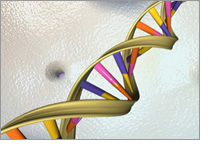Last updated: August 01, 2012
Researchers Assemble Second Non-Human Primate Genome

Researchers Assemble Second Non-Human Primate Genome
Rhesus Macaque DNA Sequence Available in Free, Public Databases
 BETHESDA, Md., Thurs., Feb. 9, 2006 - A multi-center team has deposited the draft genome sequence of the rhesus macaque monkey into free public databases for use by the worldwide research community, the National Human Genome Research Institute (NHGRI), one of the National Institutes of Health (NIH), announced today.
BETHESDA, Md., Thurs., Feb. 9, 2006 - A multi-center team has deposited the draft genome sequence of the rhesus macaque monkey into free public databases for use by the worldwide research community, the National Human Genome Research Institute (NHGRI), one of the National Institutes of Health (NIH), announced today.
The rhesus macaque (Macaca mulatta) is the second non-human primate, after the chimpanzee (Pan troglodytes), to have its genome sequenced, and is the first of the Old World monkeys to have its DNA deciphered. Overall, the rhesus genome shares about 92 to 95 percent of its sequence with the human (Homo sapiens) and more than 98 percent with the chimpanzee. Consequently, the rhesus provides an ideal reference point for comparisons among the three closely related primates. Sequencing is also underway on the genomes of a number of other primates, including the orangutan, marmoset and gorilla.
The sequencing of the rhesus genome was conducted at the Baylor College of Medicine Human Genome Sequencing Center in Houston, the Genome Sequencing Center at Washington University in St. Louis and at the J. Craig Venter Institute in Rockville, Md., which are part of the NHGRI-supported Large-Scale Sequencing Research Network. The DNA samples used in the sequencing came from a female rhesus macaque at the Southwest Foundation for Biomedical Research in San Antonio.
Independent assemblies of the rhesus genome data were carried out at each of the three sequencing centers using different and complementary approaches. A team led by Granger Sutton, Ph.D., at the J. Craig Venter Institute, then joined the resulting data into a single, high-density draft, or "melded assembly." This collaborative venture also made use of existing resources: the reference sequence of the human genome, published rhesus DNA mapping resources and the rhesus DNA fingerprint database from the Michael Smith Genome Sciences Center at the British Columbia Cancer Agency in Vancouver. The new, high-quality assembly, which covers 93 percent of the rhesus genome, will enable researchers to make evolutionary comparisons and accurate gene predictions for this important organism.
Because of its genetic, physiologic and metabolic similarities with humans, the rhesus macaque is the major, non-human primate used for the study of human disease, and also serves as an important system in drug development. Rhesus macaques are used for essential research in neuroscience, behavioral biology, reproductive physiology, endocrinology and cardiovascular studies. In addition, due to its response to the simian immunodeficiency virus (SIV), the rhesus is widely recognized as the best animal model for human immunodeficiency virus (HIV) infection. It also serves as a valuable model for studying other human infectious diseases and for vaccine research.
The availability of the rhesus genome sequence will facilitate study in these areas by enabling researchers to build a list of rhesus genes, as well as a list of differences between the rhesus, the chimpanzee and humans. A group of scientists has been organized to speed more detailed analyses of the rhesus data.
The worldwide research community can access the sequence data through the following public databases and genome viewers: GenBank (www.ncbi.nih.gov/Genbank) and Map Viewer (www.ncbi.nlm.nih.gov/mapview/) at NIH's National Center for Biotechnology Information (NCBI); EMBL Bank (www.ebi.ac.uk/embl/index.html) at the European Molecular Biology Laboratory's Nucleotide Sequence Database; and the DNA Data Bank of Japan (www.ddbj.nig.ac.jp). The data can also be viewed through the UCSC Genome Browser (www.genome.ucsc.edu/) at the University of California at Santa Cruz and the Ensembl Genome Browser (www.ensembl.org) at the Wellcome Trust Sanger Institute in Cambridge, England. Additional information about the rhesus sequence is available through the Human Genome Sequence Center at Baylor College of Medicine (www.hgsc.bcm.tmc.edu/)
NHGRI approved efforts to decipher the genome of the rhesus macaque based on its evaluation of the importance of such efforts to biomedical research. The sequencing needed to produce a high-quality draft took about two years to complete and cost approximately $22 million.
To read the white paper that outlines the scientific rationale and strategy for sequencing the rhesus, go to: www.genome.gov/sites/default/files/genome-old/pages/Research/Sequencing/SeqProposals/RhesusMacaqueSEQ021203.pdf. To learn more about the rapidly expanding field of comparative genomic analysis, go to: www.genome.gov/11509542/comparative-genomics-fact-sheet/.
NHGRI is one of 27 institutes and centers at NIH, an agency of the Department of Health and Human Services. The NHGRI Division of Extramural Research supports grants for research and for training and career development at sites nationwide. Information about NHGRI can be found at: www.genome.gov.
Contact:
NHGRI
Geoff Spencer
spencerg@mail.nih.gov
Baylor College of Medicine Human Genome Sequencing Center
Ross Tomlin
713 798-7973
htomlin@bcm.edu
Genome Sequencing Center at Washington University, St. Louis
Joni Westerhouse
314 286-0120
westerhousej@wustl.edu
J. Craig Venter Institute
Barbara Askjaer
240 268-2767
baskjaer@venterinstitute.org
